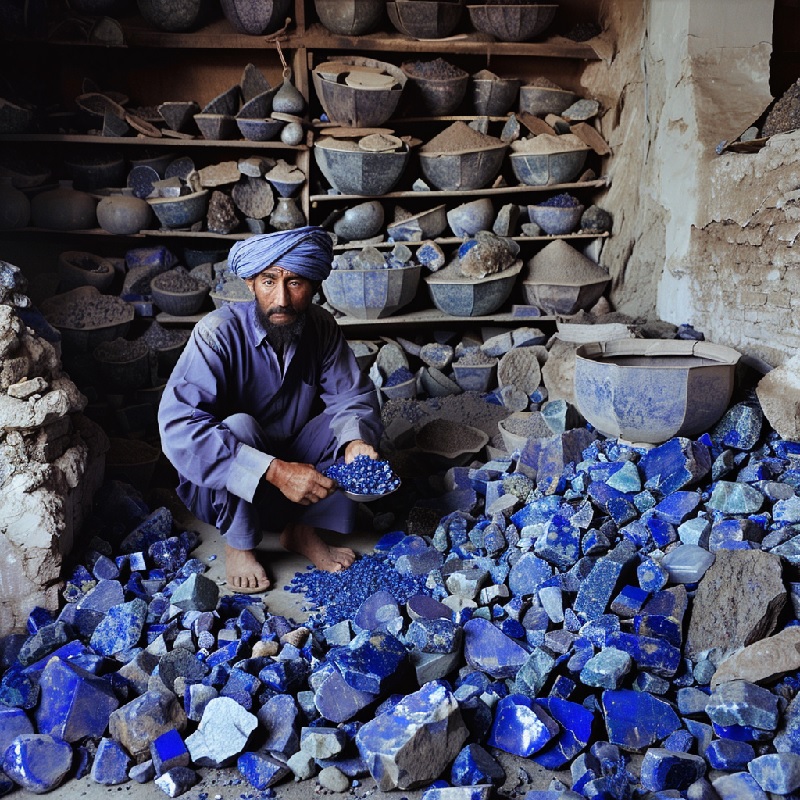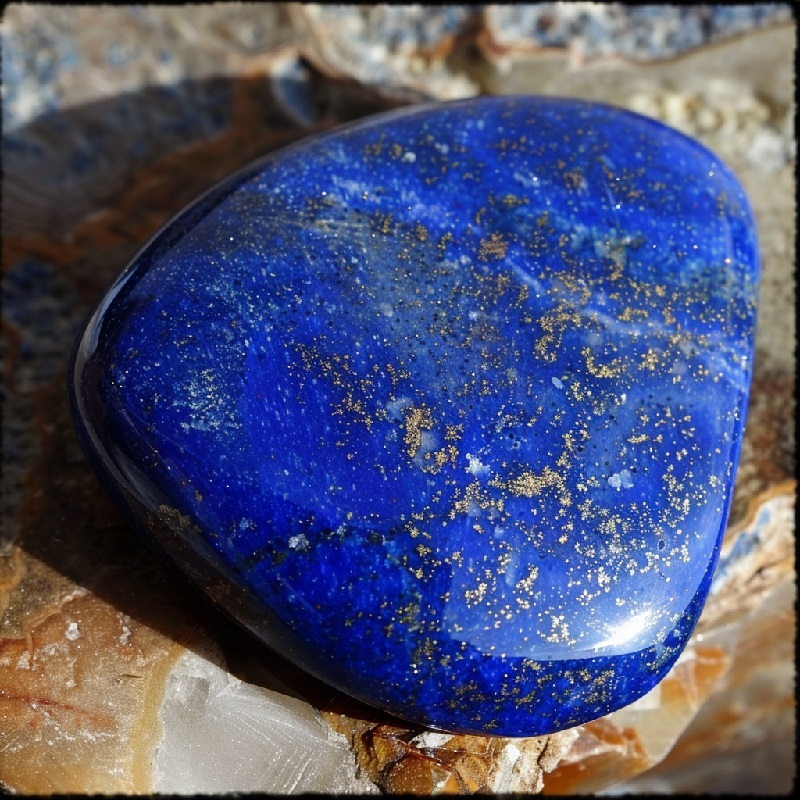Lapis Lazuli Mining
DESCRIPTION:
Lapis Lazuli is the most revered gem in the history of mankind. The color of the gem is celestial blue, symbolizing qualities such as wisdom, truthfulness, power, honor, and royalty. It is highly sought after due to its attractive color, considered one of the most precious jewels. In Egypt, this gem is regarded as the most valuable possession and is sometimes referred to as sapphire. The Holy Bible also mentions this stone, as it was one of the stones embedded in the breastplate of the High Priest in Jerusalem. The value attributed to this stone by ancient people is one reason it is considered holy. The positive vibrations of the stone enhance all the good qualities within us, earning it the title of the Stone of Truth.
Lapis lazuli is primarily found in the mountains of Afghanistan, Chile, the Soviet Union, and the United States. Egyptian kings and queens held it in high regard, not only for its preciousness but also for its spiritual significance. They believed that wearing garments dyed with lapis lazuli would elevate them to the power of God and bring about total transformation in their lives.
Similarly, in different parts of the world, this exceptional stone symbolizes starry nights, serves as protection from the evil eye, and is used as an ornament to enhance beauty. It is believed to radiate positive vibrations to mankind and is thought to impart wisdom and aid in finding solutions to professional and personal problems. This powerful crystal has the ability to activate all positive qualities in human beings. It is believed in Egypt that when a person dies, this gem is buried with them to protect their body.
This highly sought-after gem has been used for centuries, and its popularity continues today, with many longing to possess it proudly. Pyrite crystals are often embedded in these gems, enhancing their beauty and sparkle. Another important characteristic of this gemstone is its softness compared to other gems, necessitating careful protection to prevent scratches. As it is not transparent, it can be carved into beads used in bracelets, chains, and other jewelry.
The color of this precious stone is natural, and artificial dyeing is generally not performed. In rare cases, if the original stone is lighter, it may be dyed to achieve a deeper blue color. The most exceptional solid blue crystal stones are highly prized above most other gemstones. This stone is in high demand due to its believed ability to strengthen psychic abilities. Gemstones similar to lapis lazuli include azurite and sodalite.
MINING AND PROCESSING:
Lapis lazuli mining and processing involve several distinct steps to extract and prepare this coveted gemstone. Here's an overview of the process:
Prospecting and Exploration:
The first step in lapis lazuli mining is prospecting and exploration to identify potential deposits. This involves geological surveys, mapping, and sampling to pinpoint areas where lapis lazuli might be found. Prospecting may also involve traditional knowledge passed down through generations in regions known for lapis lazuli.
Site Preparation:
Once a promising lapis lazuli deposit is identified, site preparation begins. This includes clearing vegetation, leveling the ground, and setting up infrastructure for access and transportation. In some cases, particularly in remote or rugged terrain, establishing suitable infrastructure can be challenging.
Mining Methods:
Lapis lazuli is typically mined using traditional methods that vary depending on the geological setting and deposit size:
Open-Pit Mining: In areas where lapis lazuli occurs near the surface, open-pit mining may be employed. This involves removing overburden (soil, rocks) to expose the lapis lazuli-bearing rock.
Shaft Mining: In deeper deposits, shaft mining methods are used. Vertical shafts are sunk into the ground to reach the lapis lazuli veins, and tunnels (adits) are driven horizontally to access the gem-bearing rock.
Hand Mining: Particularly in artisanal and small-scale mining operations, lapis lazuli may be extracted manually using hand tools and techniques.
Extraction and Processing:
Once mined, lapis lazuli-bearing rock is transported to processing facilities for extraction:
Crushing and Grinding: The raw lapis lazuli rock is crushed and ground into smaller particles or powder to release the embedded lazurite crystals—the primary component responsible for its blue color.
Sorting and Washing: The crushed material is sorted to separate the usable lapis lazuli from waste rock and impurities. Washing may be used to further clean and concentrate the material.
Cutting and Shaping:
After extraction and initial processing, the lapis lazuli is shaped into usable forms:
Cutting: Skilled artisans cut the lapis lazuli into rough shapes suitable for further processing.
Shaping: Using traditional methods, the rough lapis lazuli pieces are shaped into desired forms such as cabochons, beads, or small sculptures.
Polishing and Finishing:
Polishing is a crucial step to enhance the luster and beauty of lapis lazuli:
Polishing: The shaped lapis lazuli pieces are polished using abrasives and polishing compounds to achieve a smooth, glossy finish that highlights its color and natural patterns.
Finishing: Optional finishing touches such as coating or sealing may be applied to protect the surface and enhance durability.
Market Preparation:
Once polished and finished, lapis lazuli products are prepared for sale:
Grading: Gemstones and higher-quality lapis lazuli pieces are graded based on color, clarity, and overall quality.
Packaging and Distribution: Finished lapis lazuli products are packaged and distributed to local markets or exported internationally to meet consumer demand.
Environmental Considerations:
Sustainable mining practices are increasingly important in lapis lazuli mining to minimize environmental impact and promote responsible resource management. This includes reclamation of mined areas and adherence to environmental regulations.
PHYSICAL PROPERTIES:
|
Name |
Lapis Lazuli |
|
Is a Variety of |
Lazurite |
|
Heat Sensitivity |
No |
|
Special Care Instructions |
Avoid contact with chemicals. |
|
Formula |
(Na, Ca)8(Al, Si)12O24(S, SO4) |
|
Etymology |
From the Persian lazhward for blue stone. |
|
Occurrence |
Occurs as a contact metamorphic mineral in limestone, formed by recrystallization of impurities; also found in granites. |
|
Inclusions |
Pyrite (brassy yellow) and white calcite in massive material. |
|
Colors |
Deep blue, azure blue, violet-blue, greenish blue. |
|
Fracture |
Uneven |
|
Hardness |
5-6 (depending on impurity content) |
|
Cleavage |
Imperfect; none in massive material. |
|
Wearability |
Good |
|
Crystallography |
Occurs as a contact metamorphic mineral in limestone, formed by recrystallization of impurities; also found in granites. |
|
Refractive Index |
1.50-1.55 |
|
Birefringence |
None |
|
Luminescence |
Fluorescent, UV-Long, UV-Short, X-ray Colors; may fluoresce whitish in SW, with orange spots or streaks in LW (Afghanistan and Chile), dimmer and more pink in SW. X-rays cause a yellowish glow in streaks. |
|
Pleochroism |
None. |
|
Optics |
Isotropic. Index of refraction around 1.50. |
|
Luster |
Dull |
|
Specific Gravity |
Pure: 2.38-2.45; gem-quality lapis: 2.7-2.9 or higher if pyrite content is significant. |
|
Enhancements |
Commonly dyed, heat treated, fracture filled, and wax or oil impregnated. |
|
Typical Treatments |
Dyeing, fracture/cavity filling, heat treatment, infusion/impregnation, oiling |
|
Transparency |
Opaque |
NATURAL OCCURRENCE:
Afghanistan, Chile, Soviet Union and the United states.
AVAILABLE COLORS:
Blue

















